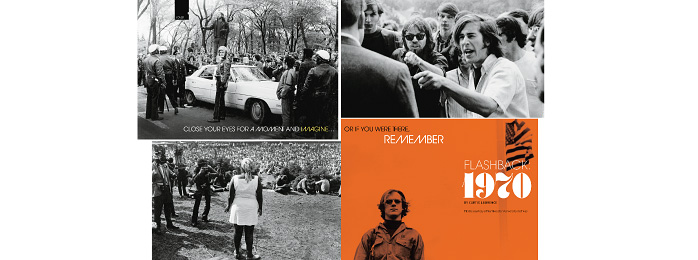
Back Talk
Readers continued to share their reflections on the tumultuous protest era at Northwestern as it was portrayed in the Weinberg magazine article “Flashback: 1970” (Spring/Summer 2015). Here are a few of their comments.
Being a student at Northwestern from 1967 to 1970 was a remarkable experience. The campus was alive with groups grappling with the politics of the Vietnam War. There was room for conservatives, liberals and radicals
to dialogue and for us to discover our own voices. Roger Friedman ’70 was an impassioned student leader who gave voice to our feelings about the war, where our peers were fighting and dying.
In the spring of 1970, Associate Professor Bernie Beck’s course “Race, Class and Power” moved conversations beyond the realm of theory and launched research in the city of Evanston. Supported by teaching assistants Lee Weiner and David Hawkins, we interviewed residents of Evanston to find out what was needed. The result was the ERTH Coffeehouse, where local youth could have a safe place to discuss the Vietnam War and the draft.
We created and ran the ERTH Coffeehouse in a storefront in Evanston, offering draft counseling, movies and homemade donuts. This remains one of my most powerful educational experiences — learning to take ideals and turn them into activism.
— Amy E. Kahn ’71
Clinical Psychologist and founder of the EMDR, Trauma Recovery Network of Western Massachusetts
I’d like to clarify a few things about the student protest at Northwestern University in the late 1960s and early 1970s. I was a leader in the Northwestern chapter of SDS (Students for a Democratic Society), along with Steve Lubet ’70, Jeff Rice ’72, Ed Steinhart ’71 and Paul Greenberg ’71. I have written one of the few books on the subject, Student Protest and the Technocratic Society: The Case of ROTC (Chicago: Adams Press, 1973).
First, Eva Jefferson Paterson ’71 was not the leader of the revolt or of the Black students. The true leader of the Black Student Sit-in was James Turner, a charismatic graduate student in sociology, with help from some
very able undergraduates. Northwestern administrators were more amenable to the Black students’ demands (more admissions, more scholarships, a place for their group FMO — For Members Only — to meet) than they were to our more radical demands.
In large measure, our revolt failed in elementary ways. We failed because the technocracy was too strong, too determined and too “turned off” by our style and tactics. The liberal reformistic approach also failed because it viewed its duties in a piecemeal fashion — change a little here and a little there.
The war continued; ecological disasters continued; the grinding poverty and violence in the ghetto continued … and the ROTC stayed on campus.
I wrote the above words 45 years ago in 1971. They are still true today, but surprise, surprise, we have a democratic socialist named Bernie Sanders running for president of the United States who wants to create a kind of revolution similar to the one we started decades ago. The question is — will we fail again or will we succeed?
— Jack Nusan Porter, Ph.D. ’71
Associate, Davis Center for Russian and Eurasian Studies, Harvard University
Editor’s note: While the original article did not state that Eva Jefferson Paterson led the Black Student Sit-In of 1968, it should have emphasized that James Turner was the leader of that action. We appreciate the opportunity to clarify the matter.
The Fall/Winter 2015 issue of Weinberg magazine inadvertently omitted the names of several loyal Wilson Society members who have been of great service to the College:
Bonnie Daniels ’69
Donna Petkanics ’80
Frank Schmitz ’85
Weinberg magazine regrets the omission.
Back to top